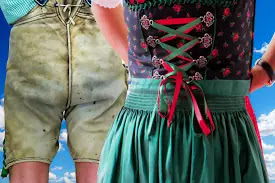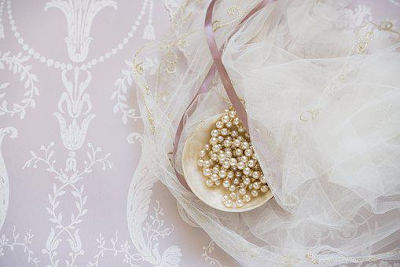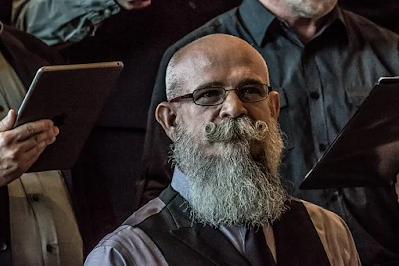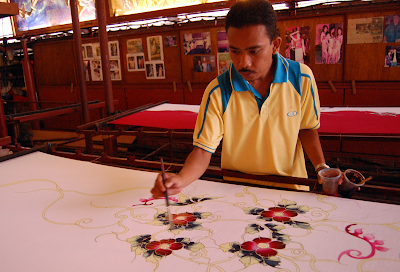Featured
- Get link
- X
- Other Apps
APRONS
An apron is a garment that covers the front of the body (from the French naperon, a small tablecloth).
People have worn them as protective clothing, ceremonial symbols of marriage and parental status, rank and group membership, and as ornaments for ages across the globe.
Sacred aprons were worn by Cretan fertility deities and Assyrian priests.
Egyptian monarchs flaunted their wealth by donning aprons adorned with jewels.
In fact, tradesmen were dubbed "apron men" in general because aprons were so common that several trades had distinct styles.
Gardeners, spinners, weavers, and garbage collectors wore blue aprons, butlers wore green, butchers wore blue stripes, cobblers wore "black flag" aprons to protect themselves from the black wax they used, and English barbers were known as "checkered apron men."
Stonemasons donned white aprons to protect themselves from the dust of their profession, and aprons are still worn as part of Ma sonic ceremonial clothing in the twenty-first century.
Young ladies in modern South Africa wear beaded aprons to commemorate their coming of age.
Decorative aprons had become fashion accessories for European women with lifestyles that allowed for such luxury and display by the year 1500.
Over the years, their popularity ebbed and flowed.
Aprons were well-established in European women's clothing by the time colonists arrived in North America.
Aprons from the United States of America.
Some Native American women and men wore aprons for both utilitarian and ceremonial purposes.
Functional aprons have been worn by colonial immigrants and their descendants for labor over the years, while beautiful aprons have gone in and out of vogue.
Well-heeled ladies wore elegant, lavishly im broidered aprons from 1900 until the 1920s, only one century ago.
Women working outside the house in the 1930s and 1940s wore whatever protective clothing their employment needed, such as coveralls, smocks, or aprons.
They worked in full-length aprons with deep pockets at home.
Many people in the early 2000s in the United States thought of aprons as 1950s kitsch, but aprons demand more serious and comprehensive attention.
Many aprons are excellent examples of textile craftsmanship; more importantly, aprons are icons—symbols of popular culture.
They bring up two images: the mythology of mom and family in the comfortable, homey days of old, and the reality of the never-ending toil of those times.
Aprons have come to symbolize an idealized, apple-pie baking Mom who reminds me of June Cleaver.
Cartoonists dress up a stick figure in an apron to indicate that she is a mother and most likely a housewife.
Despite being a created caricature, she has had a lot of influence as a role model—often wearing an apron.
The postwar period of the 1940s and 1950s was when this stereotypical housewife—and American women's aprons—were at their peak.
Rosie the Riveter lost her well-paying work, and the media and government, and therefore the job market, encouraged her to stay at home and raise her children.
Aprons—both commercial and homemade—were the uniform of the professional housewife as sewing machines and fabric became more widely accessible.
Many 1950s aprons were embellished with sewing, cleaning, cooking, and "mom" themes to dress up housekeeping.
For the holidays, this apron-wearing housewife acted as the family hostess and donned elaborate serving aprons.
Then wore a more practical model while getting everything ready in the kitchen, but she changed into her festive dress just before entering the dining room.
Although commercial aprons were available, many festive aprons were fashioned from scratch.
They were frequently constructed of netting and festooned with ribbons, sequins, and felt, and were not only created by the housewife herself, but also sold at church and neighborhood bazaars.
At least one all-season party apron was on hand for the ready hostess.
She had many, if possible, to complement her clothes.
They were flamboyant and flirty, and they were often sheer.
Aprons were also included as my hostess gifts.
The postwar homemaker was both practical and inventive.
She produced aprons using leftover fabrics, kitchen curtains, dish towels, handkerchiefs, and flour sacks.
She addressed both style and utility while making her aprons.
Many 1950s handmade aprons include one-of-a-kind patterns and features.
The apron-wearing mother amassed a collection of souvenir aprons, ranging from state maps to "Indian aprons" that bore just a passing resemblance to actual ethnic attire.
She wore her letting-off-steam apron that proclaimed, "The heck with housework," or the one that featured a distressed washerwoman with the message, "Life can be beautiful" when she had "had enough" at home.
When "the man of the house" returned from the war in the 1950s, he was expected to spend weekends at home, therefore "men's" aprons with barbeque and bartender motifs were popular.
The age of glorified housekeeping, as well as the heyday of aprons, had passed by by the early 1960s.
Aprons, however, are still worn.
The unisex butcher/barbecue style has developed from at-home cooking aprons.
Aprons are also taking on a new function at work as "the instant uniform." An apron placed over a variety of outfits gives a fast food chain or bargain retailer a uniform appearance.
Generic aprons are sent in from Central Supply and branded with corporate insignia, and aprons have lost their diversity, aesthetic enjoyment, and distinctive expression.
Aprons may disclose a lot about the lives of women.
A homemade apron, in addition to meriting study as a handcrafted one-of-a-kind item, may also contain clues about the life and times of the woman who made and wore it; and a store-bought apron found at an estate sale or tique shop may yield information about the time from which the garment came and the woman who bought and wore it.
WHERE DID THAT APRON COME FROM?
If a lady hands you the aprons she's been keeping for years, discuss each one with her.
When did she make it or get it? What was the occasion for which she wore it? However, apron dating is both an art and a science for anonymous aprons.
Look for aprons similar to yours in vintage periodicals, catalogs, or patterns.
Take a look at the apron's design.
What kind of outfit does the apron cover? Once you've figured out your dress form, browse at photographs of antique clothes to figure out what decade your apron belongs to.
Examine the cloth. What is the age of it? Look over any decorations.
What embel lishment methods and materials are employed, and when were they popular? Take note of the colors. Colors come and go in vogue.
Check hairdos, clothing, appliances, furnishings, or any other indications whether the fabric has a printed image.
If it's a store-bought apron, look at the label for information.
See also:
Protective Clothing.
References And Further Reading:
Barber, Elizabeth Wayland. Women’s Work. The First 20,000 Years, Women, Cloth, and Society in Early Times. New York: W. W. Norton and Company, 1994.
Cheney, Joyce. Aprons: Icons of the American Home. Philadelphia: Running Press, 2000.
Aprons: A Celebration. Philadelphia: Running Press, 2001.
Florence, Judy. Aprons of the Mid-Twentieth Century, To Serve and Protect. Atglen, Pa.: Schiffer Books, 2002.
McKissack, Patricia. Ma Dear’s Aprons. New York: Alfred A. Knopf, 1997.
- Get link
- X
- Other Apps















